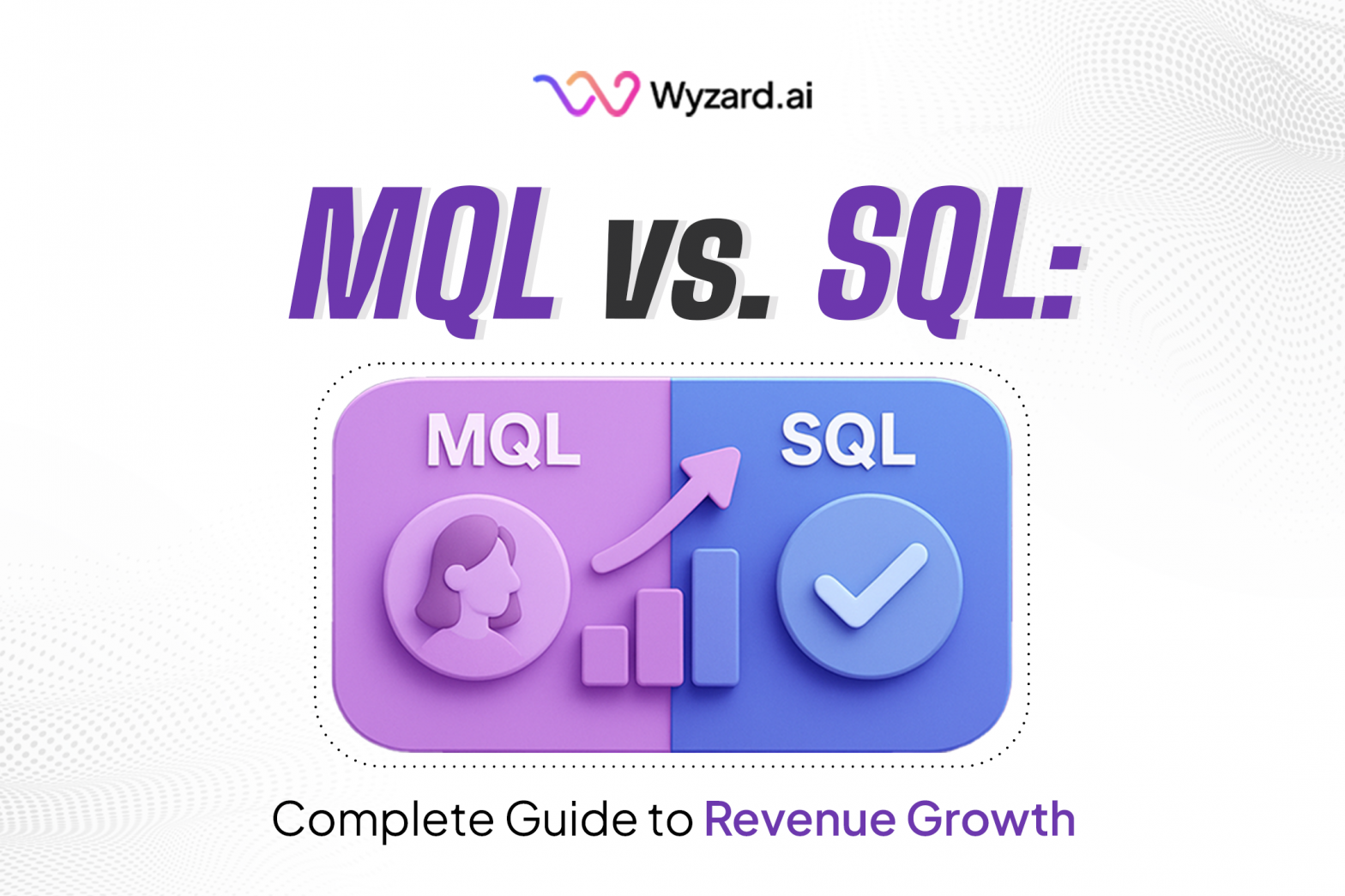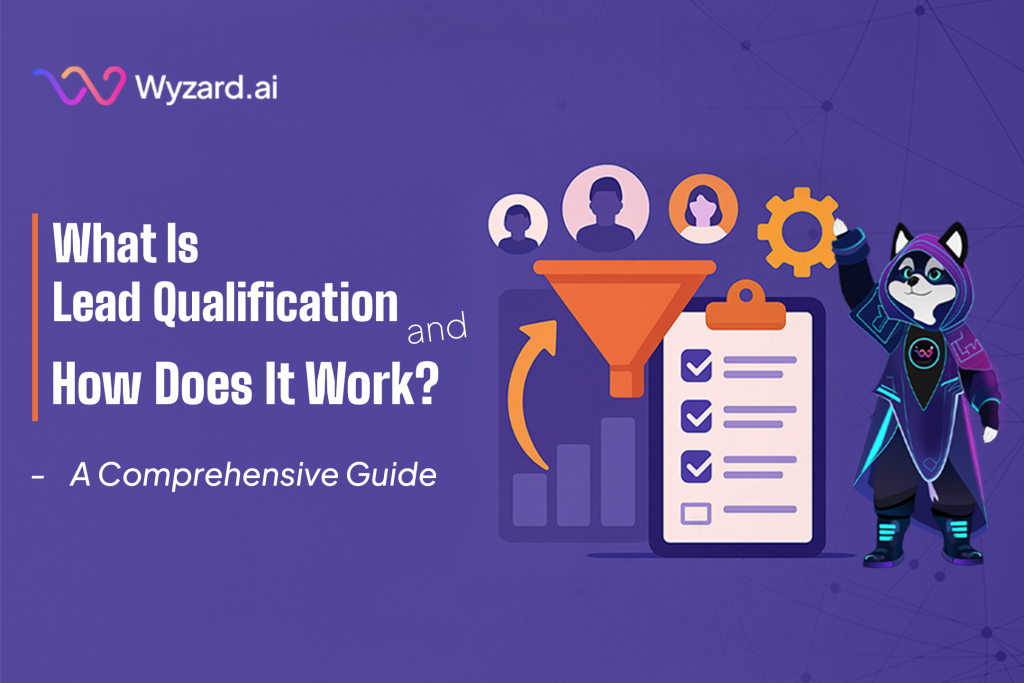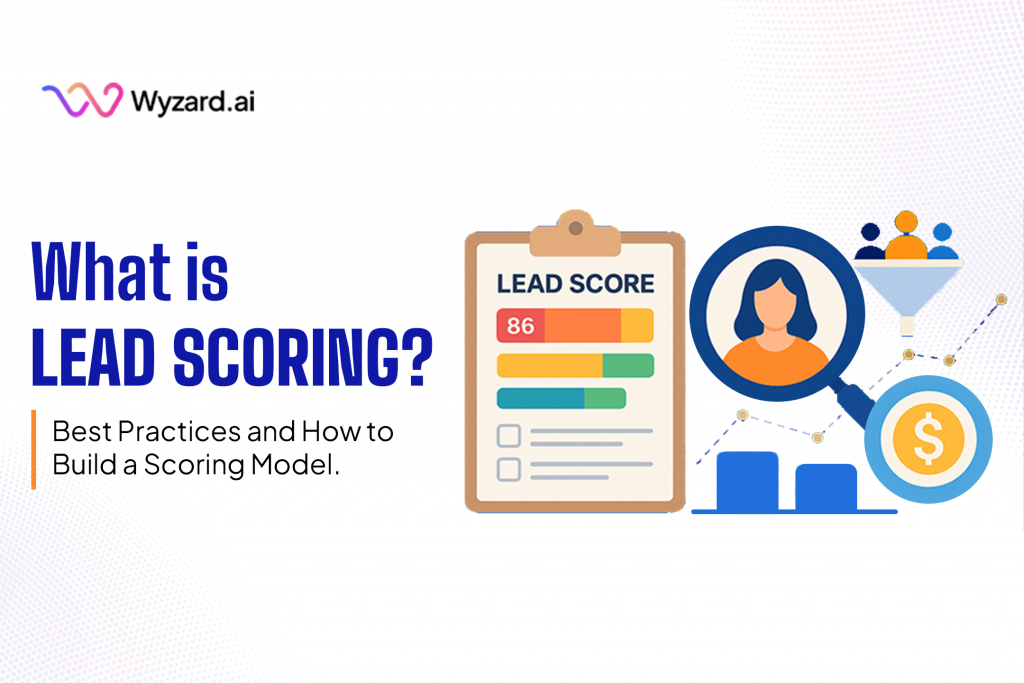80% of sales teams waste time chasing leads that were never going to buy. Meanwhile, qualified prospects slip through ...

Subscribe Now
You’re sitting on 500 fresh leads. But by month’s end, only 15 deals cross the finish line. It’s not a pipeline problem, it’s a velocity problem. While competitors turn the same lead volume into 40+ customers, your funnel stalls where it matters most: moving marketing-qualified leads into sales-qualified wins. Wyzard helps you pinpoint and eliminate that friction, accelerating conversions where other teams slow down.
Most businesses struggle with the MQL vs SQL handoff because they treat qualification as a binary decision rather than a strategic process. Teams either pass unqualified leads too early or hold qualified prospects too long, creating friction that kills conversions.
Companies that master the difference between MQL and SQL see 67% shorter sales cycles and 208% higher marketing ROI. The secret lies in understanding behavioral signals, implementing intelligent scoring, and creating seamless transitions between marketing and sales teams.
60 Second Summary
- MQL vs. SQL is the critical handoff that determines how much revenue your marketing and sales teams actually generate.
- Marketing Qualified Leads (MQLs) are prospects who show early interest. Things like downloading content, filling out forms, or frequenting your site.
- Sales Qualified Leads (SQLs) are further along: they’ve demonstrated real buying intent and authority, typically validated through frameworks like BANT.
- The real difference comes down to readiness: MQLs still need nurturing, while SQLs are ready for direct sales conversations.
- Seamless transitions rely on three things: behavioral lead scoring to track engagement, shared qualification criteria that both teams buy into, and real-time data flow so no hot prospect gets lost.
- Modern, AI-powered tools can spot high-intent signals automatically, prioritize leads based on real buying behavior, and trigger instant sales follow-ups as soon as a lead is ready.
- Companies who optimize this handoff consistently see higher conversion rates and faster sales cycles.
Key MQL vs SQL Differences and Strategies to Drive Revenue Growth
The MQL vs SQL distinction represents far more than simple lead categorization. This classification system determines how your entire revenue organization prioritizes prospects, allocates resources, and drives conversions.
Marketing qualified leads represent prospects showing initial interest through engagement behaviors. Sales qualified leads demonstrate both interest and genuine purchase intent backed by budget, authority, and timeline. Understanding this difference between MQL and SQL prevents your sales team from wasting time on unready prospects while ensuring marketing doesn’t prematurely abandon engaged leads.
Revenue-focused organizations recognize that effective MQL vs SQL processes require alignment between marketing and sales teams. Marketing must understand what sales needs for successful conversions, while sales must respect marketing’s nurturing timeline for developing prospects appropriately.
What is the Difference Between an MQL and an SQL?
The fundamental difference between MQL and SQL lies in readiness and qualification depth. Marketing qualified leads exhibit interest through digital engagement, while sales qualified leads meet specific criteria indicating genuine purchase potential.
MQLs typically demonstrate interest through content consumption, website visits, email engagement, or event attendance. These behaviors signal awareness and consideration but don’t confirm buying authority or timeline.
SQLs have been further qualified through direct interaction, needs assessment, and framework validation. Sales teams can confidently invest time in these prospects because they meet established criteria for purchase probability and deal potential.
What is an MQL?
An MQL is a marketing-qualified lead, or someone who has expressed interest in your products or solutions. These prospects have moved beyond anonymous browsing to identifiable engagement with your content and brand.
Marketing qualified leads typically exhibit behaviors like downloading whitepapers, attending webinars, visiting pricing pages multiple times, or requesting product information. The qualification comes from accumulated engagement points rather than direct sales conversation.
Modern MQL identification often relies on lead scoring systems that track digital behavior patterns. Prospects earn points for various actions, with higher scores indicating stronger interest and readiness for sales engagement.
What is SQL?
An SQL is a sales-qualified lead, or someone who is interested and intends to make a purchase. These prospects have been directly evaluated by sales teams and meet specific qualification criteria.
Sales qualified leads move beyond interest demonstration to need confirmation and purchase capability validation. Sales teams have typically conducted discovery conversations, confirmed fit, and established genuine opportunity potential.
Effective SQL qualification often follows frameworks like BANT (Budget, Authority, Need, Timeline) or MEDDIC to ensure consistent evaluation standards across all prospects.
Why the Difference Between MQL and SQL is Important
Understanding the difference between MQL and SQL prevents resource waste and improves conversion efficiency across your entire revenue organization. Misalignment between these stages creates bottlenecks that damage both team productivity and prospect experience.
Sales teams receiving unqualified MQLs waste time on prospects not ready for purchase conversations. Marketing teams passing prospects too late miss optimal engagement windows when interest peaks highest.
Proper MQL vs SQL distinction enables appropriate resource allocation. Marketing can focus on nurturing and education for MQLs while sales concentrates on qualification and closing for SQLs.
Lead Behavior in MQL vs SQL Classification
Lead behavior patterns provide crucial insights for distinguishing between marketing qualified leads and sales qualified leads. Different actions indicate varying levels of purchase intent and readiness.
MQL behaviors typically include content consumption, email engagement, social media interaction, and general website browsing. These activities suggest interest but don’t confirm purchase timing or capability.
SQL behaviors involve deeper engagement like pricing page visits, demo requests, competitor comparison research, or direct inquiry submission. These actions indicate active evaluation and potential near-term purchase decisions.
Advanced behavioral tracking systems can identify subtle intent signals that predict transition readiness from MQL to SQL status more accurately than traditional scoring methods.
Lead Scoring for MQL vs SQL Transitions
Lead scoring mechanisms bridge the gap between MQL vs SQL classification by quantifying prospect engagement and readiness levels. Effective scoring considers both demographic fit and behavioral indicators.
MQL scoring typically emphasizes volume and frequency of engagement across various touchpoints. Points accumulate through content downloads, email opens, website visits, and social media interactions until prospects reach predefined thresholds.
SQL scoring incorporates qualification criteria like company size, budget indicators, decision-making authority, and timeline urgency. These factors carry higher weights because they directly correlate with purchase probability.
Modern AI-powered lead qualification systems analyze thousands of behavioral signals to predict transition timing more accurately than manual scoring approaches.
The Future of MQL vs SQL is Wyzard.
AI-powered qualification systems can identify optimal transition timing from marketing qualified leads to sales qualified leads based on behavioral patterns rather than arbitrary score thresholds.
Predictive models analyze historical conversion data to determine which MQL characteristics most strongly predict SQLsuccess and ultimate purchase probability.
Automated engagement systems can nurture marketing qualified leads while simultaneously qualifying them for SQLstatus through intelligent conversation and data collection.
Modern revenue teams require intelligent systems that can identify intent signals and engage prospects at precisely the right moments.
Wyzard’s Marketing Copilot transforms the MQL vs SQL process by automatically identifying high-intent prospects and initiating relevant conversations in real-time. Rather than waiting for manual qualification, our AI engages prospects when intent signals peak and seamlessly transitions qualified leads to sales teams with complete context.
Stop losing revenue to slow qualification processes and manual handoffs.
Book a demo and see how AI-powered lead qualification can accelerate your MQL to SQL conversions while improving overall sales efficiency.
How to Transition a Lead from an MQL to an SQL
Successful transitions from marketing qualified leads to sales qualified leads require systematic processes that respect prospect readiness while maximizing conversion potential.
Start with clear handoff criteria that both marketing and sales teams understand completely. Define specific behaviors, scores, or triggers that indicate SQL readiness rather than relying on subjective judgment calls.
Implement intelligent engagement systems like Wyzard that can identify high-intent moments and alert sales teams immediately. In B2B SaaS, deals aren’t always won by the best product. They’re won by the fastest response. Speed is your competitive advantage. When an MQL signals readiness, a rapid move to SQL is often the deciding factor, especially since competitors are targeting the same prospects.
Get the Right Data to Develop Leads into Customers
Budget. Does the prospect have the budget to make a purchase?
Understanding financial capacity prevents pursuing opportunities that cannot close regardless of interest level or solution fit.
Authority. Does the prospect have the authority to make purchasing decisions?
Identifying decision-makers early ensures you’re engaging with people who can actually approve purchases rather than influencers or researchers only.
Need. Does your solution address the prospect’s pain points and fill a need?
Confirming genuine need alignment prevents investing time in prospects seeking different solutions or having different priorities.
Timeline. How long will the prospect’s organization take to make a purchase decision?
Understanding decision timelines helps prioritize prospects and set appropriate follow-up schedules for maximum conversion probability.
How to Map MQLs and SQLs to the Sales Funnel
MQL mapping typically aligns with awareness and consideration stages where prospects research problems and evaluate potential solutions. Marketing teams focus on education and relationship building during these phases.
SQL mapping corresponds to decision and purchase stages where prospects actively evaluate vendors and prepare for buying decisions. Sales teams concentrate on demonstration, negotiation, and closing activities.
Effective sales funnel optimization requires clear stage definitions that specify what behaviors and qualifications move prospects between MQL and SQL classifications.
Pro Tip to Prioritize Leads with High Purchase Intent
Advanced intent detection systems can identify prospects showing multiple buying signals simultaneously. Prioritize these high-intent sales qualified leads for immediate attention regardless of traditional scoring thresholds.
Look for behavioral clusters indicating active evaluation like pricing research combined with competitor analysis and stakeholder sharing. These patterns suggest imminent purchase decisions requiring urgent sales engagement.
Modern AI marketing copilots can automatically detect these complex behavioral patterns and alert sales teams instantly when prospects exhibit multiple intent signals simultaneously.
Advanced MQL vs SQL Optimization Strategies
Sophisticated organizations implement dynamic qualification that adjusts MQL vs SQL criteria based on lead source, prospect behavior, and market conditions rather than using static thresholds.
Account-based approaches modify marketing qualified lead and sales qualified lead criteria for high-value target accounts. Enterprise prospects might require higher qualification standards while small business leads could transition more quickly.
Seasonal adjustments account for industry-specific buying patterns that influence when prospects are most likely to progress from MQL to SQL status based on budget cycles or implementation timelines.
Technology Integration for MQL vs SQL Success
Marketing automation platforms should seamlessly share data with CRM systems to ensure both teams have complete visibility into prospect progression from marketing qualified leads to sales qualified leads.
Real-time alerts notify sales teams immediately when MQLs meet SQL qualification criteria rather than waiting for periodic reviews or manual checks that create delays.
Advanced analytics track conversion rates, time-to-conversion, and quality metrics across the MQL to SQL transition to identify optimization opportunities and process improvements continuously.
Measuring MQL vs SQL Performance
Track conversion rates from marketing qualified leads to sales qualified leads to identify potential bottlenecks or qualification criteria problems that prevent smooth transitions.
Monitor time-to-conversion metrics that reveal how long prospects typically remain in MQL status before advancing to SQL classification across different lead sources and prospect types.
Analyze closed-won rates for sales qualified leads versus initial MQL characteristics to refine scoring algorithms and improve future qualification accuracy.
Common MQL vs SQL Pitfalls to Avoid
Passing unqualified MQLs to sales teams creates frustration and wastes resources while potentially damaging prospect relationships through premature sales pressure.
Holding qualified prospects too long in MQL status allows competitors to engage and potentially win deals that should have been prioritized earlier.
Inconsistent qualification standards between marketing and sales teams create confusion and suboptimal handoff processes that hurt conversion rates significantly.
Stop losing revenue to slow qualification processes and manual handoffs. Book a demo.
FAQ
MQL (Marketing Qualified Lead) comes first. MQLs are leads that have engaged with marketing content, while SQL (Sales Qualified Lead) are leads that are deemed ready for sales engagement.
In HubSpot, MQLs are leads who have shown interest through interactions with marketing efforts (like website visits or downloading content), while SQLs are leads that have been qualified by sales as having the potential to convert into customers.
A good MQL to SQL ratio typically ranges between 20-30%. However, it depends on the industry and the effectiveness of your marketing and sales teams.
The MQL to SQL funnel represents the stages through which leads move from marketing qualification (MQL) to sales qualification (SQL). It is part of the overall sales funnel, which tracks the conversion of leads into paying customers.
No, MQL and SQL are not the same. MQL refers to a lead that has shown interest in marketing, while SQL refers to a lead that is qualified by sales and is ready for further engagement.
Typically, around 20-30% of MQLs convert into SQLs, though this can vary depending on factors such as industry, lead quality, and the effectiveness of your qualification process.
Other blogs
The latest industry news, interviews, technologies, and resources.
Why INBOUND 2025 Matters for AI‑First GTM
How a West‑coast debut, record attendance, and a surge of AI innovation set the stage for Wyzard.ai’s biggest ...

July 2, 2025
What Is Lead Scoring? Best Practices and How to Build a Scoring Model
Imagine Sarah from Acme Corp just downloaded your pricing guide, attended yesterday's product demo, and clicked "Talk to Sales", ...

 Want to scale pipeline across web, email, ads and events? Grab the new GTM playbook
Want to scale pipeline across web, email, ads and events? Grab the new GTM playbook



